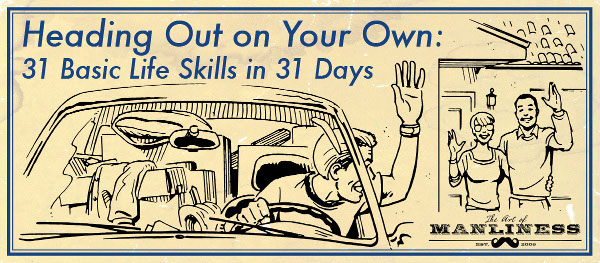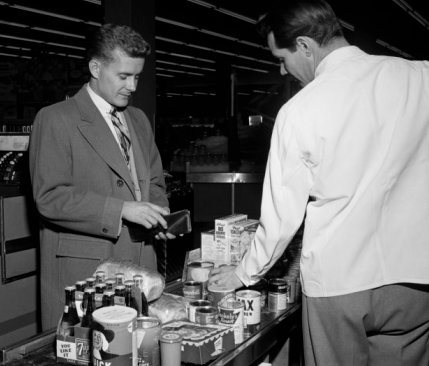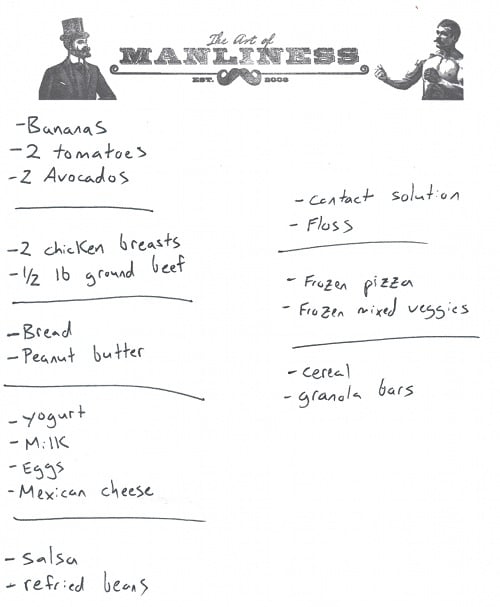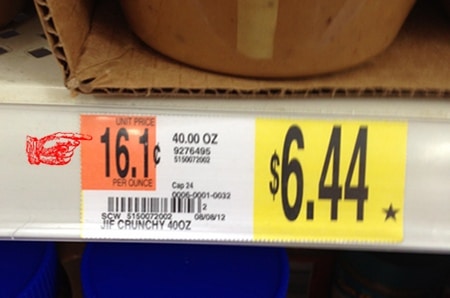
This article series is now available as a professionally formatted, distraction free paperback or ebook to read offline at your leisure.
This is the one post we didn’t originally have on the schedule for this series, but when we saw it listed several times when we asked for recommendations at the start, we decided to include it.
I can definitely see why it was requested. There are many chores that parents have their children participate in while they’re growing up, but usually mom and dad retain exclusive control over grocery shopping. Thus, when a young man leaves home, he finds himself blinking under the fluorescent lights of the local supermarket, thousands of products stretched out before him. That first outing he may feel a little giddy as he wheels his very own shopping cart around the store, but that thrill quickly turns to dismay when he finds mid-week that even though he dropped some major coin at the register, he now has nothing to eat.
Below we share some basic tips so that you can cruise the aisles of the supermarket with confidence and get the most bang for your buck.
Deciding Where to Shop

Back in the old days you either made your own food or bought what you needed from the single general store in town. Now, we have almost an embarrassment of options when it comes to where to procure our food. It can be hard to sort through all those options, so below we provide their pros/cons along with a little description of each:
Traditional Supermarket (Safeway, Walmart Neighborhood Market, Kroger)
- Pros: accepts coupons, plenty of in-store specials, large selection of products, fruits and vegetables out of season, customer loyalty card discounts.
- Cons: produce is typically trucked in from various parts of the country/world and is not as fresh, more selection can entice you to buy products you don’t need, higher prices than discount stores.
A traditional grocery store offers one-stop convenience – you can pick up bacon, toilet paper, and shampoo in one trip. But you pay for this convenience with higher prices on things that aren’t on sale or you don’t have a coupon for. But if you shop the advertised in-store specials at straight supermarkets, you can save a fair amount.
Warehouse Store (Sam’s Club, Costco)
- Pros: discounts on groceries, gas, and a wide range of products from suitcases to televisions.
- Cons: requires a $55 annual membership fee, less product selection, you may not need such huge quantities of something, doesn’t accept coupons other than their own.
Warehouse stores offer discounts to shoppers by selling products in bulk – big pallets of toilet paper or huge jugs of soy sauce. Whether the hassle of this system and the annual membership fee required are worth it is much debated. That you can save a good deal of money on things is not in dispute; bloggers have documented it. But to expand on the “cons” listed above, it’s important to mention a few caveats:
- People assume that every item at a warehouse store is the best deal in town, but this isn’t always the case. You can often get much better prices by using a coupon or taking advantage of an advertised special at a grocery store, and this is true even for things like shampoo and toilet paper.
- Because of the wide range of products available outside of things like food and paper goods, you can be tempted to buy things you don’t need.
- When you buy something in bulk, you may not be able to use it all up before it goes bad. This is an especially important consideration for the young bachelor, as he may not have room to store big pallets of stuff, and won’t be gobbling up groceries like a family of six.
In general, for a young man just heading out on his own, I don’t think a warehouse store membership is beneficial. If you do get one, split it with a friend (you can share a card if you go together), and stick with buying non-perishables.
Ethnic Grocery Stores
- Pros: unique products and cuts of meat, often cheaper prices on produce/meat/spices, fresher meats and produce.
- Cons: narrow selection of goods, “American†products (e.g., Oreos) are more expensive.
It can be fun to check out your local Indian, Asian, or Mexican supermarket to see the things they carry that no other store in town does. When I make carne asada, I like to go to the supermercado to get freshly made tortillas and a selection of Mexican pastries.
You may have heard the urban legend that ethnic grocery stores have lower prices on items like meat and produce because they don’t have to follow the same safety standards as other establishments. But this is a misconception. The lower prices are due to the store sourcing the products more directly and cutting out the middleman.
In my experience, ethnic grocery stores aren’t generally as clean as traditional ones, but maybe that isn’t such a bad thing!
Outlet Grocery Store (local variations)
- Pros: big discounts on products
- Cons: less fresh food, ever-changing selection, questionable items
An outlet grocery store stocks what might be turned “supermarket hand-me-downsâ€: dented cans, products that are about to hit or have surpassed their “use by” dates, Christmas-themed cereals in July, stuff a traditional store decided not to carry anymore, and so on. You can get some great deals on these “second-rate†items, but you have to shop carefully. Dented cans and expired meat and dairy can make you sick (see below for more information about expiration dates).
For those on the Eastern half of the country, Aldi is a different kind of discount grocery store to check out. While groceries at outlet stores are discounted because they’re “second-rate,†Aldi cuts prices by mainly offering only a small selection of their own decent quality house brand, only accepting cash, debt, or EBT cards (no credit cards or checks), stocking the few aisles with products still in boxes and pallets, and making you bring your own grocery bags and “rent†a shopping cart for 25 cents (you get your quarter back when you return the cart).
Natural/Health/Organic Grocery Stores (Whole Foods, local natural food stores)
- Pros: big selection of fresh/natural/organic groceries+unique products+specialty health items (gluten-free, vegetarian/vegan, vitamins/supplements), cheaper bulk items like grains and spices.
- Cons: less selection of products overall, higher prices
While many traditional supermarkets have begun to carry a selection of natural and organic groceries, natural grocery stores have a much wider array of these items and are reliable sources of things like grass-fed beef and free range chicken. At the same time, if you’re looking for Cheetos or cream of mushroom soup, you’re out of luck.
Prices at health grocery stores are higher than traditional grocery stores, but the higher prices do (generally) net you a more natural product. And bulk items, like spices and grains, can be cheaper here.
Farmer’s Market
- Pros: very fresh and tasty food, a chance to support local farmers.
- Cons: higher prices, may only be held once a week, what is available changes with the seasons.
Many cities and towns hold weekly farmer’s markets where farmers in the area come and sell their produce, meat, and baked goods. It’s a fun thing to attend (take a date!), the goods are fresh and delicious, and it’s nice to stick it to agribusiness by supporting local farmers. The pitfall is that the prices can be pretty steep.
____________
So there you have a rundown of your main grocery shopping options. And with these choices come more choices: many people decide to do their shopping at more than one store. For example, you might budget money to buy your meats and produce at a natural food store, while buying your staples at a discount store. Or you might shop at different traditional supermarkets each week according to which store has the best deals on what you need that week. These advertised specials can be found online and as inserts in the Sunday newspaper. Some stores like Wal-mart will match the prices of other stores’ advertised specials, and that can save you from running from store to store.
Of course many folks find the convenience of getting everything they need at a one-stop-shop like Wal-Mart outweighs any other factor.
There are other things to consider as well:
- By driving around to more than one store to score a deal, will I negate the savings with the gas I burn?
- Is a store’s reputation for how they treat their employees important to me?
- If I shop at a big discount store, will I be tempted to buy more than I need, negating the savings? I don’t think this is considered enough. I’ve lately been doing most of my grocery shopping at a small natural foods store. Not because I have money to burn, but because I found that I spent about the same shopping there as when I went to Wal-Mart. When shopping at the latter, I’d always end up making unplanned purchases of junk or packaged food (oh cool, PF Changs in a bag) while at the natural food store, the selection is a lot smaller, I buy less packaged food, and I find it easier to stick to my list, so that while the prices are more expensive, I purchase less overall, and the bill comes out about the same.
Tips for Grocery Shopping Like a Pro
Always go with a list. To save time and money, always, always create a shopping list before you head to the store, and stick to it religiously. Studies done by the grocery industry have shown that 60 to 70 percent of purchases at the grocery store are unplanned. That pretty much fits my experience. I remember when I first started shopping for myself, I’d just grab things from displays that looked tasty and interesting. This wasn’t good for either my waistline or my wallet.
Here’s how to create your shopping list:
- Begin by planning out your weekly menu and then putting the needed ingredients on your list.
- After you’ve written the items for your menu, do a quick check on your staples. How’s the milk/egg/bread supply? Do you need more paper towels or tin foil? How are you doing on TP? If you feel like there’s something you need, but you can’t think of it, run through your daily routine in your mind to jog your memory (first I brush my teeth, then I floss, then I get in the shower, then I wash my hair – oh shampoo! – that’s what I needed.) Add needed items.
- Now take your rough list, and create a master list that will make your shopping trip more efficient by grouping items together that are together at the store. Here’s an example:

By grouping items on your list together that are found together at the store, you’ll avoid getting to the far side of the store, and then realizing you forgot something on the other side where you came in. You’ll need to get familiar with the layout of your grocery store to do this, but the effort is well worth it as it saves you time and hassle.
Check the unit price to get the best deal. Instead of simply looking at the overall price when deciding which product to buy, look at the unit price. The unit price tells you the price per pound, ounce, liter, etc. of a product.
Many stores have the unit price right on the shelf label, but it’s usually smaller and more discrete than the total price. Here’s a picture of Walmart’s price labels with the unit price pointed out:

If your store doesn’t display the unit price, you can figure it out yourself by simply dividing the price by the number of pounds/ounces/etc. in the package. For example, the unit price for a 10-pound package of flour costing $5.00 is $.50 a pound ($5/10 lbs = $.50).
Breaking a product’s price down like this allows you to better compare prices of different items. This is especially important when different brands package the same product in different quantities. In an effort to maximize profits, companies will package and price items in such a way that you’ll actually buy the more expensive item on a unit price basis. For example, consumers often intuitively think that if they buy the biggest box on the shelf, they’ll get the lowest unit price. For the most part that’s true, but not always, so it’s worth it to double check.
Some items have what’s called a quantity surcharge. Grocery stores will often jack up the price on products in large-sized packages, driving the unit price up. Buying the single serving or smaller sized package can actually be the better deal if a larger product has a quantity surcharge. This happens a lot with cereals, so make sure to compare before you decide to buy the big-ol’ three-pound box of Cinnamon Toast Crunch.
Go with generic brands when you can. As we discussed in our post on being a savvy consumer, generic products can be hit or miss. Many are manufactured in the same factory as the brand name product and simply given a different label. They’re discounted because they don’t have to spend money on advertising to maintain “brand awareness.†Other times, a generic is cheaper because it’s not made as well. So just do some experimenting. I always buy the generic first, and only switch if I’m dissatisfied with it.
Skip coupons. Now this is just my opinion. Plenty of people are super into couponing and think it’s the bees knees and extremely worthwhile. Personally,I’ve tried couponing, but the payoff was never worth the time and effort. Most of the coupons you’ll find in the Sunday paper are for crap food like Dunk-a-roos and Juicy Juice boxes; it was rarely for stuff I’d buy anyway. We have to remember that coupons aren’t printed because food manufacturers want to help out our budget. Coupons are a marketing strategy to get consumers to purchase something they wouldn’t buy in the first place. I’ve also noticed that coupons get issued for stuff that’s already overpriced to begin with. I can save 15 minutes of my time and save the same amount of money buying the generic brand versus clipping a coupon for the name brand. Or I simply choose the brand that the store is running a special on.

Shoppers gonna shop
Shop on a full stomach. To save money, never shop on an empty stomach. Studies show that when shoppers visit the grocery store hungry, they usually end up spending more money on food. So go shopping after you’ve eaten a meal, when possible. If your schedule doesn’t permit that, at least have a small snack before hitting the supermarket.
Understand the difference between “sell by,†“use by,†and “best by.†It’s easy to notice that most food products come with dates stamped on them. But what’s the difference between “sell by” and “use byâ€? I honestly didn’t know myself until writing this article! But it’s a good bit of knowledge to file away as it can help you make purchasing decisions, figure out whether a bargain at a grocery outlet store is a good deal or might make you sick, and prevent you from throwing away perfectly good food (and money).
- Best by. Often found on shelf-stable products, the “best by” stamp is not a safety rating, but indicates the point up until which the product will offer the best quality and flavor. After that date, the texture and taste may change, but it can still be safe to consume.
- Sell by. Perishables like meat, dairy, and bakery goods are frequently given a “sell by” stamp. This label tells the store how long to display an item on their shelves. You should always buy a “sell by†item before the date given, but it’s not a safety indicator, and the product may still be good for days or weeks after you bring it home and the date has expired, as long as you store it properly.
- Use by. “Use by” is the only designation that indicates that the product may no longer be safe after that date. It is actually used more often as a “best by†label, but since these products can spoil faster than others, always consume a “use by” product on or before that date to be on the safe side. When buying a “use-by” product, make sure you’ll have time to consume it before the date given.
When it comes to perishables like milk, always reach to the back of a shelf to grab a carton; the store will put products which are closer to reaching their “sell by” date up at the front of a shelf or on the top of a stack while the fresher ones will be in the back or on the bottom.
Once you bring a product home, cook a “use by” product on or before the date given, and store “sell-by” perishables at 40 degrees or below and “best by” items in a cool, dry cabinet.
To figure out how long you can store a “sell by” or “best by†item (or an item without a date), before you have to cook, consume, or freeze it, consult a “keep it or toss it” database. The answers may surprise you — for example, did you know you can keep eggs for 3-5 weeks after the date on the package? Checking dates can prevent you from throwing away a ton of food! (But always look at the appearance of an item and give it a sniff for spoilage, too, before consuming!)
How to Check If Produce Is Ripe
Picking produce is tricky. You don’t want to buy fruits and vegetables that are too ripe (if you buy them and don’t eat them right away, they’ll go to waste), nor do you want them to be so under-ripe that you’ll have to wait a few days before you can eat them.
For the first few years of my adult life, I had no idea how to pick fresh produce. I’d go to the produce section and sort of “ape†what I saw my mom do when I went to the grocery store with her as a boy. I’d pick fruits and vegetables up to squeeze and smell them. The entire time, however, I would be thinking, “I have no clue what I’m doing.”
After several trips of me mindlessly fondling the produce, I finally did some research on what I should actually be looking for when selecting it.
Picking Ripe Fruit
- See it. For some fruits like apples, bananas, and tomatoes, you can tell it’s ripe simply by looking at its color. If you don’t plan on using the fruit for a while, it’s a good idea to buy it green at the store so it has time to ripen up at home. Avoid fruits with dark spots or bruises, which indicate the fruit has been damaged.
- Squeeze it. As fruit ripens, the substances that hold the cells together break down and convert to water-soluble pectins, which make the fruit become softer and softer. Thus, a soft squeeze is a good test for ripeness. You want the flesh of the fruit to be firm, but give a little bit to the touch. If it’s rock hard, it’s not ripe; if it’s mushy, it’s over-ripe. The squeeze test is useful on fruits like peaches, pears, plums, avocados, and kiwis. It’s not as helpful on fruits with thick rinds like melons and pineapples. Although if you feel like giving your pineapple a gentle, loving squeeze, that’s your prerogative.
- Smell it. Chemical changes take place in ripening fruits that produce fruity smells. Sniff the blossom end of the fruit (the end opposite of the stem). You’re looking for a light, sweet smell. If it smells sour or overly fruity, it’s probably over-ripe.
- Heft it. Juiciness is an important attribute for fruits like watermelons, cantaloupe, and tomatoes. To ensure you get the juiciest piece of fruit, pick it up in your hand and heft it. The heavier the fruit, the juicier it’s likely to be.
Picking Ripe Vegetables
- See it. Look for vegetables that are evenly colored. You want leafy greens that are dark in color. The darker the leaf, the more flavor they have. Some brown spots on lettuce and kale should be expected, but overall they should be nice and green. If a vegetable looks wilted, pass it over.
- Squeeze it. Unlike fruit, you want vegetables to be as firm as possible. Vegetables that are wilted and soft just aren’t very appetizing. Broccoli, potatoes, carrots, cucumbers, onions, peppers, and cauliflower should all be firm to the touch. Leafy greens like lettuce, kale, and cabbage should snap with a nice crisp sound.
For more info on selecting vegetables, check out this handy guide.


